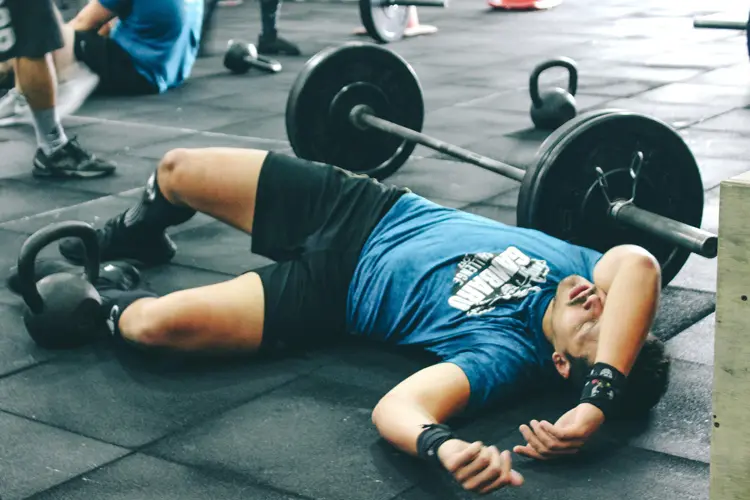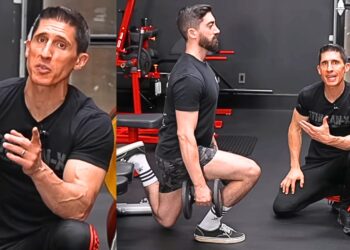Squatting is one of the two most efficient lower body movements that you can perform to build serious leg strength.
(The other, in case you’re wondering, is Lunges.)
Most resistance trainees and bodybuilders include squats in their Leg Day workouts—typically performed 1 to 3 times each week, depending on workout structure.
However, squatting every day has proven in a number of circumstances to provide highly targeted, high-intensity training that can develop serious lower body strength. Daily squat workouts are a tool used by powerlifters and weightlifters to accelerate leg muscle development and increase lower body power.
But is it safe to squat every day? Can it actually lead to serious muscle growth?
Those are the two questions that immediately spring to mind when thinking about performing an exercise every day. Below, we’re going to take a deep dive into the science and give you an answer to help you know whether or not you should consider squatting every day.
Level Up Your Fitness: Join our 💪 strong community in Fitness Volt Newsletter. Get daily inspiration, expert-backed workouts, nutrition tips, the latest in strength sports, and the support you need to reach your goals. Subscribe for free!
Is There a Scientific Case For or Against Squatting Every Day?
Science has proven that regular training is vital for developing muscular strength, but there are very real risks of overtraining. For this reason, the American College of Sports Medicine recommends resting for 48 hours between training periods.
Studies on resistance training frequency have examined how often it’s recommended that you train the same muscle—in this case, your lower body muscles using front and back squats.
A 2016 study made it clear that training specific muscles twice a week led to better results than once-a-week training, but concluded, “whether training a muscle group three times per week is superior to a twice-per-week protocol remains to be determined.”
Another study in 2019 backed up the “twice is better than once” theory, with “a similar change noted” based on the frequency of training.
One 2018 study took a look at the pros and cons of increasing training frequency, putting participants through 1 to 4 workouts per week. They found that there was “no significant effect of RT frequency on muscular strength gains”, but suggested that “greater training frequencies can be used for additional RT volume, which is then likely to result in greater muscular strength gains.”
This was reinforced by a study from the same year which found that “high-frequency resistance training does not seem to offer additional strength and hypertrophy benefits over lower frequency when volume and intensity are equated. Coaches and practitioners can therefore expect similar increases in strength and lean body mass with both 3 and 6 weekly sessions.”
Notice the word “volume” in both of those two studies? As research has proven, it’s volume, not resistance training frequency that leads to better results. Amount of Weight Lifted x Reps x Sets is more important for strength increases than the number of times per week that a muscle is exercised.
If raising your workout volume is the key to seeing strength and size gains, training daily could be an excellent solution to hit your target. Instead of performing 12-15 sets per Leg Day, which you train twice per week, you could instead perform 4-7 sets every day of the week. Given a six-day training schedule, that comes out to significantly more reps and sets (higher volume).
Of course, you need to be aware that overtraining is a very real possibility with squatting every day. Without sufficient time to rest and recover between heavy lifts, the muscle fibers damaged by your workouts may not be able to repair fully.
As one 2020 study put it, “continuously high training loads with insufficient recovery may cause fatigue to accumulate and result in overtraining.” The study found no solid connection between overtraining and injury, but did mention “a sustained decrease in performance” as a result of monotonous and frequent high-intensity training.
A 2021 study, however, did find that there are elevated injury risks with overtraining. To be fair, it was conducted on athletes rather than resistance trainees, but the results are still valid for all high-intensity exercise. The athletes who over-trained showed biomarkers of skeletal muscle injury, as well as damage to the heart muscles. They also had elevated oxidative stress levels.
Thankfully, there was no long-term damage to their bodies and the athletes recovered after periods of minimal training.
What does this mean for you?
- Volume is what matters most. If squatting every day helps you get more volume in your workouts, then it may be a good idea to consider.
- Overtraining is a risk. Be aware of that, and pay attention to your body so you’ll spot signs of stress as a result of your high-intensity training. It’s all about listening to your body and doing what works best for you!
Benefits of Squatting Every Day

Squatting every day—also known as the “Bulgarian method”—does offer some benefits. Though there is little clear-cut evidence to provide concrete proof, bodybuilders who try this training modality often find that it helps them in a number of ways:
More work, more sessions. As mentioned above, weightlifting results are more due to higher volume than increased frequency. By spreading out the work over multiple sessions, you can add more sets and reps to each workout. You can shorten your training sessions while still maximizing the volume of your workouts over the course of the week.
More focus. If squats are your weakness, using the Bulgarian method helps you to focus on training that specific exercise every day. Over time, your posture and form will improve, your lower body strength will increase, and you will squat more effectively.
This is also effective if you’re working toward a competition or personal record. By focusing specifically on the same exercise every day, you increase the strength of the specific muscle combination required to perform that movement. The result: greater power, and ultimately better performance.
Better variety. With the practice of squatting every day, you can focus on both your squats
and another muscle group. For example, Monday is Squats + Chest, Tuesday is Squats + Back, Wednesday is Squats + Shoulders and Arms, and so on.
Level Up Your Fitness: Join our 💪 strong community in Fitness Volt Newsletter. Get daily inspiration, expert-backed workouts, nutrition tips, the latest in strength sports, and the support you need to reach your goals. Subscribe for free!
For busy resistance trainees who don’t have 2+ hours to spend at the gym every day, fewer squats per day gives you the option to train other muscles while still guaranteeing sufficient squat volume per week.
Minimized session fatigue. Over the course of a longer session, muscle fatigue sets in as you burn through available energy stores and shred muscle fibers. When this happens, your risk of injury is greatly increased—due both to exhaustion and poor quality posture.
It’s just the way our bodies work: as we tire, we focus less on our posture and form, and instead focus on just getting through the difficult exercise/surviving the burn.
But with the Bulgarian method of squatting every day, you stop before you hit total failure or reach a stage where you’re fatigued enough that your posture and form suffers. This drastically decreases your overall injury risk!
Read also: 12 Benefits of Deadlifts Everyone Should Know About
Risks of Squatting Every Day
Of course, there are some very real risks that come with performing the same exercise day after day:
Demanding daily schedule. If you’re trying the Bulgarian method of squatting every day, you have to lift those weights and hit those sets/reps day in and day out, rain or shine, no matter what happens. This can be difficult for people who follow an unpredictable schedule (like shift workers or long-haul truckers, for example).
The demanding daily schedule also doesn’t account for the typical problems that crop up during the average work-week, some of which may prevent you from getting in your workout.
Mentally taxing. It’s a well-known fact that repetition leads to boredom, and, as mentioned in the studies cited above, boredom can lead to decreased workout performance and possibly burnout. Performing the exact same exercise day after day might not be sustainable mentally, and your enjoyment of your workouts may decrease over time.
Neglects other muscles. With squats, you use the exact same combination of muscles (quads, hamstrings, glutes, lower back, calves, feet muscles, etc.) in the exact same movement pattern (straight up and down) every time. That is great for developing squatting power, but not for much more.
What happens when you’ve trained your squat every day but need to switch things up to Lunges? Or what about the upper back or chest muscles you’ve neglected because you’re focused exclusively on squats?
This is the opposite of “skipping Leg Day problems”—doing Leg Day every day can lead to weakness among your other muscles, as well as decreased mobility and flexibility.
Higher injury risk. Your muscles need time to recover between workouts, because the strain of the squats causes micro-tears in the muscle fibers. If you work out the same muscle every day, the tears don’t have time to heal fully. Over time, particularly if you’re training very heavy, the risk of more serious (larger and more painful) muscle tears increases.
You also put your joints at risk by performing the same exercise day after day. Joints are prone to repetitive motion injuries, including sprains, strains, bursitis, tendonitis, and more. They, like muscles, need rest in order to recover, which is why it’s recommended to train muscles no more than every other day (48-hour rest).
These aren’t necessarily reasons to avoid the Bulgarian method, but they’re risk factors you need to be aware of if you’re considering incorporating this practice of squatting every day into your workout routines.
How to Squat Every Day Safely and Effectively

For those who are going to squat every day, here are some tips that can help you do it safely and maximize the effectiveness of this training method:
Alternate weight. Consider alternating training heavy one day (working to increase 1-Rep Max) and working with lighter weight (60-75% of 1-Rep Max weight) and higher rep/set volume the next day. Working a “lighter” day can help to give your leg muscles a chance to recover without losing your “every day” training.
Change up squat type. If you’re not working toward a competition, you don’t need to perform the exact same type of squat every day. Alternating between the various squats—Back, Front, Sumo, Landmine, Overhead, etc.—allows for greater flexibility in your movement, increasing your overall range of motion and balance while still hitting that squat every day.
Track everything. Write down every set and rep, every weight increase or decrease, and even how you’re feeling during the workout. Pay attention to your responses to the daily training and any aches and pains in your body. Tracking your results will help you push through a plateau or know when it’s time to change things up to protect your body against injury.
Get the right supports. Having a back brace or knee braces won’t necessarily improve your exerciser performance, as studies have proven. However, they are useful if you are fatiguing and want to protect against injuries, or you’re recovering from a previous injury.
Focus on form over weight. What matters most is that you’re squatting with the right form—that’s what will deliver the best results. If you need to lower your weight a little, do it. Focus on mastering the proper posture and transitioning through the movements properly. You’ll decrease injury risk and increase the effectiveness of the workouts. Once you’ve got the form on lock, you can get back to maxing out on weight.
Conclusion
Squatting every day, commonly known as the Bulgarian method, is a training modality that comes with many benefits, but also a number of risks. For those who are working toward a competition or want to pay special attention to a single move (squatting), it can be an effective option to increase workout volume—which, as we learned, is what matters more than frequency.
However, it’s important to know the risks involved and take the proper steps to protect your body when squatting daily.










